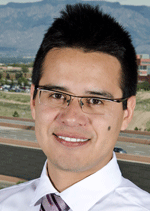Recent News
Ferenchak named chair of Transportation Research Board Pedestrian Committee
October 31, 2025
Ferenchak named APBP 2025 Research Professional of the Year
October 1, 2025
UNM professor to speak at TEDxABQ event
September 24, 2025
NSF funds research to investigate whether treated wastewater can help mitigate water scarcity in arid regions without compromising river ecosystem health
September 2, 2025
News Archives
Dr. Ricardo Gonzalez-Pinzon's Hydro-Systems Lab Completes an Unprecedented Field Campaign Along the Rio Grande Continuum
July 13, 2015
 The UNM Center for Water and the Environment - Hydro-Systems Lab spent two exciting weeks in late June (6/22-7/3) conducting a campaign of eight field experiments on the state’s rivers. Led by Civil Engineering faculty Dr. Ricardo González-Pinzón and graduate students Cameron Herrington, Vanessa Garayburu, and Jake Mortensen, the research team performed a series of tracer studies across a range of stream sizes and conditions on the Jemez River and Rio Grande continuum. Valuable assistance before and during the experiments was provided by Dr. David Van Horn from the UNM Department of Biology, Dr. Tim Covino from the Watershed Science program at Colorado State University, Dr. Diego Riveros-Iregui from the Geosciences program at University of North Carolina – Chapel Hill, and from and Dr. Dan Cadol from the Hydrology program at New Mexico Tech.
The UNM Center for Water and the Environment - Hydro-Systems Lab spent two exciting weeks in late June (6/22-7/3) conducting a campaign of eight field experiments on the state’s rivers. Led by Civil Engineering faculty Dr. Ricardo González-Pinzón and graduate students Cameron Herrington, Vanessa Garayburu, and Jake Mortensen, the research team performed a series of tracer studies across a range of stream sizes and conditions on the Jemez River and Rio Grande continuum. Valuable assistance before and during the experiments was provided by Dr. David Van Horn from the UNM Department of Biology, Dr. Tim Covino from the Watershed Science program at Colorado State University, Dr. Diego Riveros-Iregui from the Geosciences program at University of North Carolina – Chapel Hill, and from and Dr. Dan Cadol from the Hydrology program at New Mexico Tech.
Tracer studies are used in hydrology to understand solute transport and hydrologic processes in water systems. These experiments are performed by adding a tracer (typically a dye or salt) to a stream and measuring the concentration of the tracer through time at two or more locations downstream. Measurements are taken using field deployable sensors or by processing grab samples taken directly from the stream. A conservative, inert tracer (such as chloride or bromide) provides data on how water travels downstream while a reactive tracer (such as nitrate) provides data on biogeochemical processing occurring during downstream transport. The primary objective of these tracer studies was to investigate nutrient processing and solute transport at multiple locations within the same river network and expand the use of tracer studies to large rivers like the Rio Grande. The data gathered are expected to improve understanding of solute transport and nutrient processing at the river network scale. This ambitious field campaign is the first of its kind to provide a ‘snapshot’ of biogeochemical activity at the river network scale while also applying tracer studies in larger rivers than ever before.
The research team selected sites using the Strahler stream order classification to identify spatial differences in stream conditions. Sites for stream orders 1-2 were located on Jaramillo Creek within the Valles Caldera National Preserve and for stream orders 3-5 on the Jemez River near Jemez Falls, Jemez Springs, and Jemez Pueblo. Sites for stream orders 6-8 were located on the Rio Grande with sites near Taos, Albuquerque, and Elephant Butte (see map). The team selected appropriate conservative (sodium bromide) and reactive tracers (potassium nitrate and resazurin) to investigate their research questions. Additionally, the team also deployed an array of field sensors to measure water quality parameters at each field site. These instruments include Yellow Springs Instruments (YSI) EXO2 and 6920 sondes, Satlantic Submersible Ultraviolet Nitrate Analyzers (SUNA), Turner Designs C-sense and C6 sensors, and Onset HOBO water quality data loggers. Parameters measured by these instruments include conductivity, temperature, dissolved oxygen, pH, turbidity, nitrate, pCO2, and water depth. In the lab, ion chromatography is used to process stream grab samples for tracer concentrations (bromide and nitrate). This data will be used to characterize solute transport, nutrient uptake, and stream metabolism across the Rio Grande river network.
In addition to these field experiments, the Hydro-Systems Lab has also installed sediment columns at each site. These columns will remain at each site for several months to allow native microbial communities to colonize a variety of sediment substrates as stream water flows through the columns. Following this incubation period, the columns will be brought back to UNM for lab analysis using the same tracers to investigate nutrient processing by representative microbial communities throughout the river network. The Hydro-systems Lab plans to continue their investigation of the principal New Mexico river network through these lab experiments and the analysis of field tracer data gathered this summer.
Preliminary data analysis shows that the team successfully completed their tracer experiment campaign including three sites with stream discharge greater than most previously published nutrient tracer studies. The team’s success shows that logistical challenges in performing tracer experiments in large rivers and at multiple locations within a river network can be overcome. The team hopes that their success will encourage others to perform similar studies and provide currently nonexistent datasets that will further scientific knowledge of stream function at increasingly larger scales. Future plans for the Hydro-systems Lab include performing a similar tracer experiment campaign during fall/winter to characterize the influence of seasonal changes on stream biogeochemical processing.
The Hydro-Systems Lab wants to thank students Diana Baltazar, Fabian Carbajal, Elijah Davis, Justin Reale, Phil Roveto, and Dr. Abdulmehdi Ali for field and lab assistance. Also, we want to thank ReCARnation for supporting our field work with two powerful pick-up trucks which let us go places.
